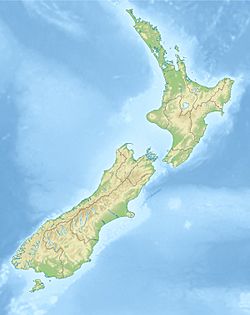1869 Christchurch earthquake facts for kids
| Local date | 5 June 1869 |
|---|---|
| Local time | 8:00 a.m. |
| Magnitude | 6.0 ML |
| Epicenter | 44°S 173°E / 44°S 173°E |
| Areas affected | South Island New Zealand |
| Max. intensity | VII–VIII |
| Casualties | None |
The 1869 Christchurch earthquake was a strong earthquake that shook the city of Christchurch in New Zealand on June 5, 1869. It happened at 8:00 in the morning, near a place called New Brighton. Scientists estimate its strength was about 6.0 on the Richter scale. The shaking was felt very strongly, reaching levels VII to VIII on the Mercalli scale. Even though it was a powerful quake, thankfully, no one was hurt.
Contents
What Happened During the 1869 Christchurch Earthquake?
This earthquake struck Christchurch early on a Saturday morning. It was a significant event for the young city, which was still growing. The quake's center was close to the coast, meaning the shaking was very strong in Christchurch itself.
How Strong Was the Shaking?
When we talk about earthquakes, we often use two main ways to measure them:
- Richter Magnitude: This measures the energy released by the earthquake at its source. The 1869 quake had a magnitude of 6.0. This is considered a moderate to strong earthquake.
- Mercalli Intensity: This measures how much the shaking was felt and the damage it caused in different places. For the 1869 earthquake, the intensity was VII to VIII.
What Do Mercalli Levels VII and VIII Mean?
- Level VII (Very Strong): People would have found it hard to stand. Furniture might have moved, and chimneys could have broken.
- Level VIII (Severe): This level means significant damage to buildings, especially those not built to resist earthquakes. Chimneys often fall, and heavy furniture can overturn.
Damage Caused by the Earthquake
Even though no one was injured, the earthquake caused noticeable damage to buildings in Christchurch. Many structures at the time were made of brick and stone, which are not as flexible as wooden buildings during an earthquake.
Buildings Affected
Several important buildings in the city showed signs of the strong shaking:
- Many brick and stone buildings had cracks or other damage.
- Chimneys were a common casualty, with many breaking or falling.
- The spire of St John's Church on Hereford Street was damaged. A spire is a tall, pointed structure on top of a church tower.
Lessons Learned for Building Construction
The 1869 earthquake taught people in Christchurch an important lesson about how to build strong buildings. Seeing the damage to stone structures made them think differently about construction materials.
Building with Timber
One important example of this lesson is the Church of St Michael and All Angels. Because of the damage seen in other stone buildings like St John's, the builders decided to use timber (wood) for the new St Michael and All Angels church. Wood is more flexible than stone or brick, which helps buildings withstand earthquake shaking better. This decision helped make the church safer for future earthquakes.


